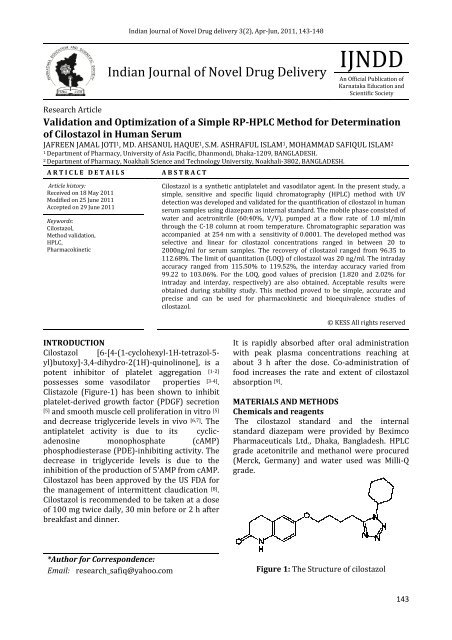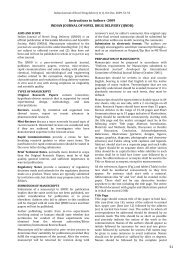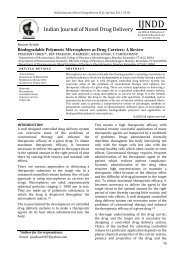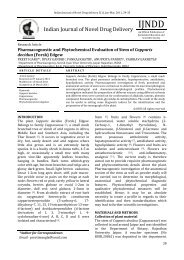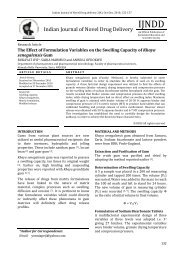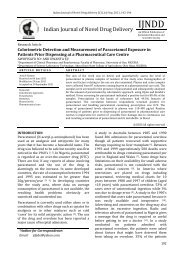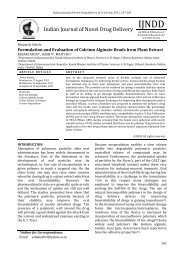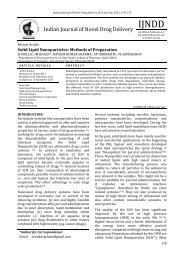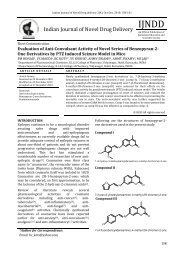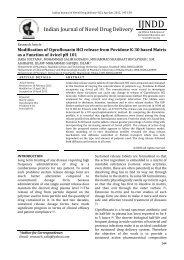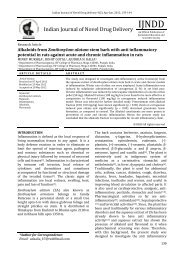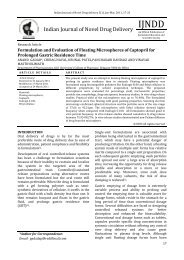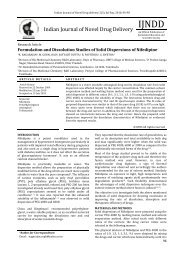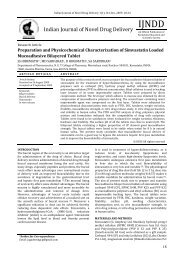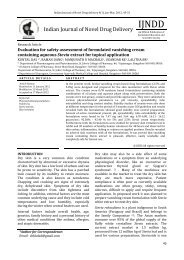Validation and Optimization of a Simple RP-HPLC Method for ...
Validation and Optimization of a Simple RP-HPLC Method for ...
Validation and Optimization of a Simple RP-HPLC Method for ...
You also want an ePaper? Increase the reach of your titles
YUMPU automatically turns print PDFs into web optimized ePapers that Google loves.
Indian Journal <strong>of</strong> Novel Drug delivery 3(2), Apr-Jun, 2011, 143-148<br />
Indian Journal <strong>of</strong> Novel Drug Delivery<br />
IJNDD<br />
An Official Publication <strong>of</strong><br />
Karnataka Education <strong>and</strong><br />
Scientific Society<br />
Research Article<br />
<strong>Validation</strong> <strong>and</strong> <strong>Optimization</strong> <strong>of</strong> a <strong>Simple</strong> <strong>RP</strong>-<strong>HPLC</strong> <strong>Method</strong> <strong>for</strong> Determination<br />
<strong>of</strong> Cilostazol in Human Serum<br />
JAFREEN JAMAL JOTI 1 , MD. AHSANUL HAQUE 1 , S.M. ASHRAFUL ISLAM 1 , MOHAMMAD SAFIQUL ISLAM 2<br />
1 Department <strong>of</strong> Pharmacy, University <strong>of</strong> Asia Pacific, Dhanmondi, Dhaka-1209, BANGLADESH.<br />
2 Department <strong>of</strong> Pharmacy, Noakhali Science <strong>and</strong> Technology University, Noakhali-3802, BANGLADESH.<br />
A R T I C L E D E T A I L S<br />
A B S T R A C T<br />
Article history:<br />
Received on 18 May 2011<br />
Modified on 25 June 2011<br />
Accepted on 29 June 2011<br />
Keywords:<br />
Cilostazol,<br />
<strong>Method</strong> validation,<br />
<strong>HPLC</strong>,<br />
Pharmacokinetic<br />
Cilostazol is a synthetic antiplatelet <strong>and</strong> vasodilator agent. In the present study, a<br />
simple, sensitive <strong>and</strong> specific liquid chromatography (<strong>HPLC</strong>) method with UV<br />
detection was developed <strong>and</strong> validated <strong>for</strong> the quantification <strong>of</strong> cilostazol in human<br />
serum samples using diazepam as internal st<strong>and</strong>ard. The mobile phase consisted <strong>of</strong><br />
water <strong>and</strong> acetronitrile (60:40%, V/V), pumped at a flow rate <strong>of</strong> 1.0 ml/min<br />
through the C-18 column at room temperature. Chromatographic separation was<br />
accompanied at 254 nm with a sensitivity <strong>of</strong> 0.0001. The developed method was<br />
selective <strong>and</strong> linear <strong>for</strong> cilostazol concentrations ranged in between 20 to<br />
2000ng/ml <strong>for</strong> serum samples. The recovery <strong>of</strong> cilostazol ranged from 96.35 to<br />
112.68%. The limit <strong>of</strong> quantitation (LOQ) <strong>of</strong> cilostazol was 20 ng/ml. The intraday<br />
accuracy ranged from 115.50% to 119.52%, the interday accuracy varied from<br />
99.22 to 103.06%. For the LOQ, good values <strong>of</strong> precision (1.820 <strong>and</strong> 2.02% <strong>for</strong><br />
intraday <strong>and</strong> interday, respectively) are also obtained. Acceptable results were<br />
obtained during stability study. This method proved to be simple, accurate <strong>and</strong><br />
precise <strong>and</strong> can be used <strong>for</strong> pharmacokinetic <strong>and</strong> bioequivalence studies <strong>of</strong><br />
cilostazol.<br />
© KESS All rights reserved<br />
INTRODUCTION<br />
Cilostazol [6-[4-(1-cyclohexyl-1H-tetrazol-5-<br />
yl)butoxy]-3,4-dihydro-2(1H)-quinolinone], is a<br />
potent inhibitor <strong>of</strong> platelet aggregation [1-2]<br />
possesses some vasodilator properties [3-4].<br />
Clistazole (Figure-1) has been shown to inhibit<br />
platelet-derived growth factor (PDGF) secretion<br />
[5] <strong>and</strong> smooth muscle cell proliferation in vitro [5]<br />
<strong>and</strong> decrease triglyceride levels in vivo [6,7] . The<br />
antiplatelet activity is due to its cyclicadenosine<br />
monophosphate (cAMP)<br />
phosphodiesterase (PDE)-inhibiting activity. The<br />
decrease in triglyceride levels is due to the<br />
inhibition <strong>of</strong> the production <strong>of</strong> 5′AMP from cAMP.<br />
Cilostazol has been approved by the US FDA <strong>for</strong><br />
the management <strong>of</strong> intermittent claudication [8] .<br />
Cilostazol is recommended to be taken at a dose<br />
<strong>of</strong> 100 mg twice daily, 30 min be<strong>for</strong>e or 2 h after<br />
breakfast <strong>and</strong> dinner.<br />
It is rapidly absorbed after oral administration<br />
with peak plasma concentrations reaching at<br />
about 3 h after the dose. Co-administration <strong>of</strong><br />
food increases the rate <strong>and</strong> extent <strong>of</strong> cilostazol<br />
absorption [9] .<br />
MATERIALS AND METHODS<br />
Chemicals <strong>and</strong> reagents<br />
The cilostazol st<strong>and</strong>ard <strong>and</strong> the internal<br />
st<strong>and</strong>ard diazepam were provided by Beximco<br />
Pharmaceuticals Ltd., Dhaka, Bangladesh. <strong>HPLC</strong><br />
grade acetonitrile <strong>and</strong> methanol were procured<br />
(Merck, Germany) <strong>and</strong> water used was Milli-Q<br />
grade.<br />
*Author <strong>for</strong> Correspondence:<br />
Email: research_safiq@yahoo.com<br />
Figure 1: The Structure <strong>of</strong> cilostazol<br />
143
Mohammad Safiqul Islam et al / Indian Journal <strong>of</strong> Novel Drug Delivery 3(2), Apr-Jun, 2011, 143-148<br />
Instrumentation<br />
A Shimadzu (Japan) <strong>HPLC</strong> system consisting <strong>of</strong> a<br />
SCL-10Avp system controller <strong>and</strong> two LC-8A<br />
pumps were used. Ultraviolet detection was<br />
achieved with a SPD-10Avp UV-VIS detector<br />
(Shimadzu, Japan). The drug analysis data were<br />
acquired <strong>and</strong> processed using LC solution<br />
(Version 1.03 SP3, Shimadzu, Japan) s<strong>of</strong>tware<br />
running under Windows XP on a Pentium PC.<br />
Chromatographic conditions<br />
The mobile phase used was a mixture <strong>of</strong> water<br />
<strong>and</strong> acetonitrile (60:40, v/v), pumped at a flow<br />
rate <strong>of</strong> 1.0 ml/min through the column (C18; 5μ,<br />
4.6 × 150 mm, Waters, USA) at room<br />
temperature. The mobile phase was degassed<br />
prior to use under vacuum by filtration through a<br />
0.2μ nylon membrane. Concentrations were<br />
measured at 254 nm by UV detector at a<br />
sensitivity <strong>of</strong> 0.0001.<br />
Preparation <strong>of</strong> calibration st<strong>and</strong>ards <strong>for</strong><br />
serum sample assay<br />
Stock solution <strong>of</strong> cilostazol was prepared having<br />
a concentration <strong>of</strong> 200 μg/ml in methanol. The<br />
stock solution was further diluted with<br />
acetronitrile to prepare the working st<strong>and</strong>ard<br />
solution having a concentration <strong>of</strong> 20 μg/ml.<br />
Diazepam (internal st<strong>and</strong>ard) stock solution<br />
(250 μg/ml) was prepared in methanol, from<br />
which a working st<strong>and</strong>ard solution <strong>of</strong> 20 μg/ml<br />
in diluent was prepared. Cilostazol calibration<br />
st<strong>and</strong>ards <strong>for</strong> serum were obtained by adding<br />
required amount <strong>of</strong> the working solution <strong>and</strong><br />
100 μl <strong>of</strong> diazepam (internal st<strong>and</strong>ard) solution<br />
(25 μg/ml) to drug free serum to achieve the<br />
cilostazol concentrations <strong>of</strong> 2000, 1000, 500,<br />
100, 50, 20, ng/ml. Then they were vortexed <strong>for</strong><br />
about 5 minutes <strong>for</strong> proper mixing <strong>and</strong> liquidliquid<br />
extraction was per<strong>for</strong>med by adding 2 ml<br />
methanol in 1 ml <strong>of</strong> each <strong>of</strong> the st<strong>and</strong>ard<br />
solutions. After vortex mixing, they were<br />
centrifuged at 10,000 rpm <strong>for</strong> 5 minutes <strong>and</strong> the<br />
supernatants were collected.<br />
All these st<strong>and</strong>ards were stored at −30 0 C until<br />
further analysis <strong>and</strong> analyzed by the above<br />
mentioned <strong>HPLC</strong> method <strong>for</strong> the construction <strong>of</strong><br />
calibration curves <strong>and</strong> method validation. In all<br />
cases, the injection volume was 10 μl.<br />
Preparation <strong>of</strong> QC samples<br />
A series <strong>of</strong> quality control serum samples were<br />
prepared by adding blank serum with 100 μl <strong>of</strong><br />
diazepam (internal st<strong>and</strong>ard) solution (25<br />
μg/ml) <strong>and</strong> required amount <strong>of</strong> cilostazol to yield<br />
the final serum samples <strong>of</strong> 10, 100, 2000 ng/ml<br />
<strong>of</strong> cilostazol. These samples were then vortexed<br />
<strong>for</strong> 2 minutes <strong>and</strong> cilostazol was extracted<br />
according to method described in the previous<br />
section.<br />
<strong>Method</strong> <strong>Validation</strong><br />
Calibration curves were constructed by using<br />
ratio <strong>of</strong> peak area <strong>of</strong> cilostazol to diazepam<br />
(internal st<strong>and</strong>ard) against the concentration <strong>of</strong><br />
cilostazol <strong>and</strong> used to determine the cilostazol<br />
concentrations in unknown samples. The<br />
following parameters were determined <strong>for</strong> the<br />
validation <strong>of</strong> the analytical method developed <strong>for</strong><br />
the determination <strong>of</strong> cilostazol in human serumspecificity,<br />
selectivity, linearity, range, precision,<br />
accuracy, limit <strong>of</strong> detection, limit <strong>of</strong> quantitation,<br />
recovery <strong>and</strong> stability [10-11] .<br />
RESULTS AND DISCUSSION<br />
<strong>Optimization</strong> <strong>of</strong> the chromatographic<br />
conditions<br />
A number <strong>of</strong> stationary <strong>and</strong> mobile phases were<br />
checked to determine the optimum separation<br />
<strong>and</strong> the highest analytical sensitivity <strong>for</strong><br />
cilostazol <strong>and</strong> such sensitivity were given by the<br />
slope <strong>of</strong> calibration curves obtained <strong>for</strong> the<br />
assayed conditions. The optimal condition, with<br />
which the best result was obtained, has been<br />
reported in the experimental section. The mobile<br />
phase consisted <strong>of</strong> acetronitrile: water (60:40) to<br />
ensure the stability <strong>of</strong> cilostazol. The mean<br />
retention times <strong>for</strong> cilostazol <strong>and</strong> the internal<br />
st<strong>and</strong>ard were 8 min <strong>and</strong> 13 min respectively.<br />
The analysis time was set at 30 min. This time<br />
assured the elution <strong>of</strong> cilostazol <strong>and</strong> diazepam<br />
without any interference. Baseline resolution <strong>of</strong><br />
the substances was achieved under the<br />
chromatographic conditions <strong>of</strong> the study. The<br />
suitability <strong>of</strong> the chromatographic system was<br />
checked daily be<strong>for</strong>e analysis by evaluating the<br />
tailing factor, the resolution <strong>and</strong> the system<br />
repeatability <strong>of</strong> three injections <strong>of</strong> a solution <strong>of</strong><br />
cilostazol (100 ng/ml) <strong>and</strong> internal st<strong>and</strong>ard in<br />
mobile phase which demonstrated good<br />
per<strong>for</strong>mance <strong>of</strong> the chromatographic system<br />
throughout the study.<br />
Selectivity<br />
Drug-free human serum samples from six<br />
different sources were analyzed to ensure<br />
selectivity <strong>of</strong> the method [12]. These<br />
chromatograms were free <strong>of</strong> interferences at the<br />
retention times <strong>of</strong> cilostazol <strong>and</strong> the internal<br />
st<strong>and</strong>ard (Figure 2 A to C). The chromatograms<br />
<strong>for</strong> serum samples are shown in Figure D.<br />
144
Mohammad Safiqul Islam et al / Indian Journal <strong>of</strong> Novel Drug Delivery 3(2), Apr-Jun, 2011, 143-148<br />
Figure 2: Representative chromatograms obtained from A) drug-free serum sample, B) serum with<br />
cilostazol, C) serum with internal st<strong>and</strong>ard <strong>and</strong> D) calibration st<strong>and</strong>ard <strong>for</strong> serum sample with<br />
cilostazol <strong>and</strong> internal st<strong>and</strong>ard<br />
Sensitivity, Linearity <strong>and</strong> Range<br />
According to IUPAC as cited in Roger Causon a<br />
method is said to be sensitive if small changes in<br />
concentration cause large changes in the<br />
response function [13]. Sensitivity can be<br />
expressed as the slope <strong>of</strong> the linear regression<br />
calibration curve, <strong>and</strong> it is measured at the same<br />
time with the linearity test. The sensitivity<br />
attainable with an analytical method depends on<br />
the nature <strong>of</strong> the analyte <strong>and</strong> the detection<br />
technique employed [14] . The linearity <strong>of</strong> the<br />
assay method was validated <strong>for</strong> serum (six<br />
st<strong>and</strong>ards) samples. The slope <strong>and</strong> the intercept<br />
<strong>of</strong> the calibration graphs were calculated through<br />
least squares by weighing linear regression <strong>of</strong><br />
cilostazol to internal st<strong>and</strong>ard peak-area ratio.<br />
The concentration <strong>of</strong> cilostazol was studied over<br />
the range <strong>of</strong> 20 to 2000 ng/ml in serum. Data<br />
were fitted to the equation y = mx + b, where y is<br />
the peak area ratio, x is the drug concentration,<br />
m <strong>and</strong> b are the slope <strong>and</strong> y-axis intercept <strong>of</strong> the<br />
calibration curve, respectively. The calibration<br />
curve was found to be linear over the specified<br />
range. To construct a calibration curve in<br />
bioanalysis, a linear regression analysis is<br />
generally used. This analysis assumes invariant<br />
regression, implying that the residuals are<br />
minimized around the dependent variable (or<br />
response) <strong>and</strong> that the independent variable (or<br />
concentration) is errorless. Other assumptions<br />
involved are the independence <strong>and</strong> normal<br />
distribution <strong>of</strong> residuals as well as their<br />
homocedasticity (equal variances).<br />
Homocedasticity was not observed in our data,<br />
as usually occurs in bio-analysis [9, 15-16]. The<br />
mean regression parameters are given in Table 1.<br />
The mean (± S.D.) <strong>of</strong> the slope <strong>and</strong> intercept <strong>of</strong><br />
the serum st<strong>and</strong>ards were 0.00030 (±0.00000)<br />
<strong>and</strong> 0.025 (±0.001), respectively. Coefficient <strong>of</strong><br />
determination was greater than 0.99 on all<br />
calibration curves in serum.<br />
Table 1: Regression data <strong>for</strong> the st<strong>and</strong>ard curve<br />
(n=6) <strong>of</strong> cilostazol in human serum<br />
Correlation<br />
coefficient<br />
Slope<br />
Intercept<br />
Serum Mean 0.994 0.00030 0.025<br />
S.D. 0.002 0.00000 0.001<br />
145
Mohammad Safiqul Islam et al / Indian Journal <strong>of</strong> Novel Drug Delivery 3(2), Apr-Jun, 2011, 143-148<br />
Table 2: Intra-day <strong>and</strong> Inter-day precision <strong>and</strong> accuracy <strong>of</strong> cilostazol in serum (n=3)<br />
Concentration (ng/ml) Concentration found Precision<br />
Accuracy (%)<br />
(ng/ml) Mean ± SD CV (%)<br />
Intra-day<br />
20 23.419 ± 0.4262 1.820 117.097<br />
500 527.301 ± 20.2679 3.844 105.460<br />
2000 2039.246 ± 10.4147 5.11 101.962<br />
Inter-day<br />
20 20.15 ± 0.4068 2.02 100.75<br />
500 566.322 ± 102.586 18.115 113.264<br />
2000 2152.156 ± 341.2767 15.857 107.608<br />
Table 3: Recovery <strong>of</strong> the bioanalytical method<br />
Cilostazol recovery from serum samples (n = 3)<br />
Quantity added (ng/ml)<br />
Mean quantity obtained<br />
(ng/ml)<br />
Recovery (%) Average recovery (%)<br />
2000 2091.914 104.5967 104.813<br />
500 527.379 105.4767<br />
20 20.87333 104.3667<br />
Table 4: Stability <strong>of</strong> cilostazol in serum QC samples in different storage conditions<br />
Concentration<br />
(ng/ml)<br />
Conditions<br />
Mean concentration in<br />
serum (ng/ml)<br />
20 After 6 hr at ambient temperature 22.536 112.68<br />
Recovery in serum<br />
(%)<br />
48 hr storage at –40 0 C 19.270 96.35<br />
3 freeze thaw cycle 20.814 104.07<br />
500 After 6 hr at ambient temperature 535.827 107.17<br />
48 hr storage at –40 0 C 538.201 107.64<br />
3 freeze thaw cycle 508.109 101.62<br />
2000 After 6 hr at ambient temperature 2093.258 104.66<br />
48 hr storage at –40 0 C 2092.965 104.65<br />
3 freeze thaw cycle 2089.518 104.48<br />
Limit <strong>of</strong> Quantitation (LOQ)<br />
The lower limit <strong>of</strong> quantification can be defined<br />
as the lowest concentration on the calibration<br />
curve with acceptable precision <strong>and</strong> accuracy<br />
(CV
Mohammad Safiqul Islam et al / Indian Journal <strong>of</strong> Novel Drug Delivery 3(2), Apr-Jun, 2011, 143-148<br />
Recovery<br />
The method <strong>of</strong> extraction <strong>of</strong> cilostazol <strong>and</strong><br />
diazepam was evaluated <strong>for</strong> efficiency <strong>and</strong> the<br />
results are shown in the Table 3. The recovery <strong>of</strong><br />
cilostazol was measured <strong>for</strong> all QC samples <strong>and</strong><br />
the average recovery was found to be 104.813%<br />
from serum samples respectively. The method<br />
showed good efficiency in terms <strong>of</strong> recovery.<br />
Stability<br />
The stability <strong>of</strong> the analyte was evaluated <strong>for</strong><br />
different under storage conditions <strong>of</strong> different<br />
temperatures. The results are depicted in the<br />
Table 4. For short term stability determination,<br />
stored serum was kept at ambient temperature<br />
<strong>for</strong> 6 hr exceeding that expected to be<br />
encountered during the routine sample<br />
preparation. Samples were pretreated <strong>and</strong><br />
analyzed as above mentioned. The mean<br />
recoveries <strong>of</strong> the low, medium <strong>and</strong> high QC levels<br />
ranged from 96.35 to 107.64% <strong>for</strong> serum<br />
samples. These results indicated reliable stability<br />
behavior under the experimental condition <strong>of</strong> the<br />
regular runs.<br />
Application <strong>of</strong> the method<br />
A few <strong>HPLC</strong>-UV, LC-MS/MS, <strong>and</strong> GC-MS methods<br />
have been reported in different literatures. Some<br />
<strong>of</strong> these methods use complicated extraction<br />
instruments, long <strong>and</strong> tedious extraction<br />
procedures, <strong>and</strong> large amounts <strong>of</strong> solvents or<br />
biological fluids <strong>for</strong> extraction while other<br />
methods have a long turnaround time during<br />
analysis. To minimize these limitations, the<br />
present investigation provides a rapid, selective<br />
<strong>and</strong> sensitive <strong>HPLC</strong>-UV method that has short<br />
<strong>and</strong> simple extraction procedure, consume small<br />
amount <strong>of</strong> solvent <strong>and</strong> biological fluid <strong>for</strong><br />
extraction with a short turnaround time. The<br />
validation data also indicates that the method is<br />
able to quantify the drug at low quantity like 6<br />
ng/ml in biological samples with good precision<br />
<strong>and</strong> accuracy. For this we can be apply this<br />
method <strong>for</strong> the quantization <strong>of</strong> cilostazol in<br />
biological samples. In comparison with the<br />
previously developed methods, the present<br />
method <strong>of</strong>fers an undoubted advantage in term<br />
<strong>of</strong> overall analytical per<strong>for</strong>mance.<br />
REFERENCES<br />
[1] Kimura Y, Tani T, Kanbe T, Watanabe K.<br />
Effect <strong>of</strong> cilostazol on platelet aggregation<br />
<strong>and</strong> experimental thrombosis.<br />
Arzneimittel<strong>for</strong>schung 1985; 35 (7A):<br />
1144-9<br />
[2] Kohriyama T, Tanaka E, Katayama S,<br />
Yamamura Y, Nakamura S. Antiplatelet<br />
therapy in patients with cerebral<br />
thrombosis at the chronic phaseassessment<br />
<strong>of</strong> its effect on coagulation <strong>and</strong><br />
fibrinolytic parameters. Rinsho<br />
Shinkeigaku. 1994; 34 (8): 771-6<br />
[3] Uchikawa T, Murakami T, Furukawa H.<br />
Effects <strong>of</strong> the antiplatelet agent cilostazol<br />
on peripheral vascular disease in patients<br />
with<br />
diabetesmellitus.<br />
Arzneimittel<strong>for</strong>schung 1992; 42 (3): 322-4.<br />
[4] Okuda Y, Mizutani M, Ikegami T, Ueno E,<br />
Yamashita K. Hemodynamic effects <strong>of</strong><br />
cilostazol on peripheral artery in patients<br />
with diabetic nephropathy.<br />
Arzneimittel<strong>for</strong>schung 1992; 42 (4): 540-2<br />
[5] Tsuchikane E, Katoh O, Sumitsuji S,<br />
Fukuhara A, Funamoto M, Otsuji S,<br />
Tateyama H, Awata N, Kobayashi T. Impact<br />
<strong>of</strong> cilostazol on intimal proliferation after<br />
directional coronary atherectomy. Am<br />
Heart J. 1998; 135(3):495-502<br />
[6] Suehiro A, Sugimoto Y, Masuda H,<br />
Kakishita E. A study <strong>of</strong> the effects <strong>of</strong><br />
cilostazol on platelet function <strong>and</strong> serum<br />
lipids in patients with diabetes mellitus.<br />
Curr Ther Res. 1993; 54 (5): 553-61<br />
[7] Elam MB, Heckman J, Crouse JR,<br />
Hunninghake DB, Herd JA, Davidson M,<br />
Gordon IL, Bortey EB, Forbes WP. Effect <strong>of</strong><br />
the novel antiplatelet agent cilostazol on<br />
plasma lipoproteins in patients with<br />
intermittent claudication. Arterioscler<br />
Thromb Vasc Biol. 1998; 18 (12): 1942-7<br />
[8] Jacoby D, Mohler ER . Drug treatment <strong>of</strong><br />
intermittent claudication. Drugs 2004; 64:<br />
1657–1670<br />
[9] Karnes, HT <strong>and</strong> March C. Calibration <strong>and</strong><br />
validation <strong>of</strong> linearity in chromatographic<br />
biopharmaceutical analysis. J. Pharm.<br />
Biomed. Anal. 1991; 9: 911-918.<br />
[10] U.S. Food <strong>and</strong> Drug Administration.<br />
Guidance <strong>for</strong> Industry: Bioanalytical<br />
<strong>Method</strong> <strong>Validation</strong>, Center <strong>for</strong> Drug<br />
Evaluation <strong>and</strong> Research, Rockville, MD.<br />
2001: 1–22<br />
[11] Krull IS, Swartz M. Analytical <strong>Method</strong><br />
Development <strong>and</strong> <strong>Validation</strong> <strong>for</strong> the<br />
Academic Researcher: <strong>Validation</strong> View<br />
Point. Analytical Letters. 1999 ;32, 1067-<br />
1080.<br />
[12] Shah VP, Midha KK, Dighe S, McGilveray IJ,<br />
Skelly JP, Yacobi A, Layl<strong>of</strong>f T. Analytical<br />
methods validation: Bioavailability,<br />
147
Mohammad Safiqul Islam et al / Indian Journal <strong>of</strong> Novel Drug Delivery 3(2), Apr-Jun, 2011, 143-148<br />
bioequivalence, <strong>and</strong> pharmacokinetic<br />
studies. J. Pharm. Sci. 1992; 81, 309-312.<br />
[13] Causon R. 1997. <strong>Validation</strong> <strong>of</strong><br />
chromatographic methods in biomedical<br />
analysis viewpoint <strong>and</strong> discussion. J.<br />
Chromatogr. B. 1997; 689:175-180.<br />
[14] Bruce P, Minkkinen P, Riekkola ML.<br />
Practical <strong>Method</strong> <strong>Validation</strong>: <strong>Validation</strong><br />
Sufficient <strong>for</strong> an Analytical <strong>Method</strong>. J.<br />
Chromatogr. A. 1998; 730: 381-394.<br />
[15] Karnes HT, Shiu G, Shah VP. <strong>Validation</strong> <strong>of</strong><br />
bioanalytical methods. Pharm. Res. 1991; 8:<br />
421-426.<br />
[16] Hartmann C, Smeyers-Verbeke J, Massart<br />
DL, McDowall RD. <strong>Validation</strong> <strong>of</strong><br />
bioanalytical chromatographic methods. J.<br />
Pharm. Biomed. Anal. 1998;17: 193-218.<br />
148


